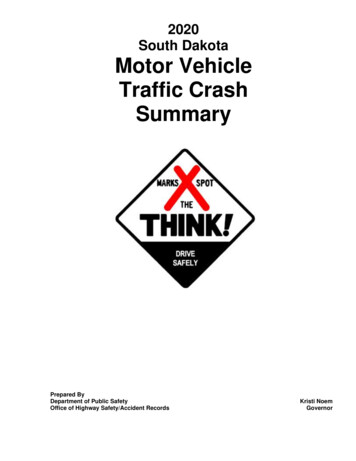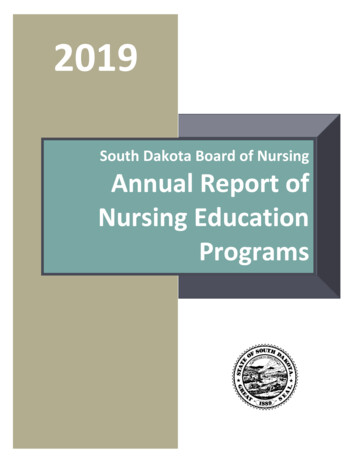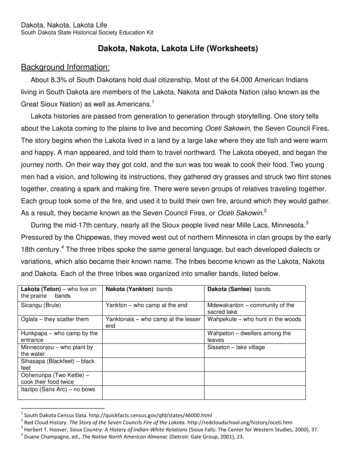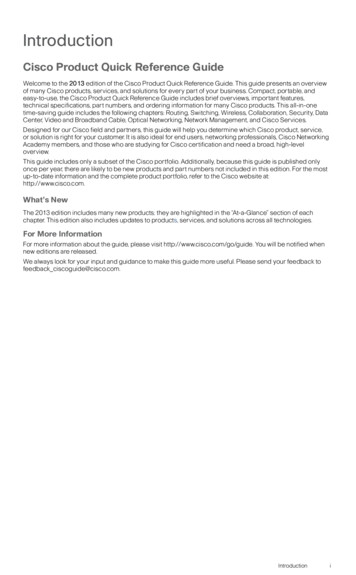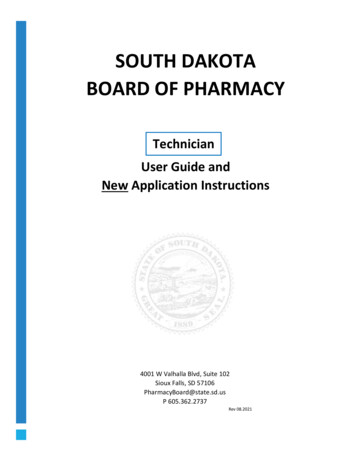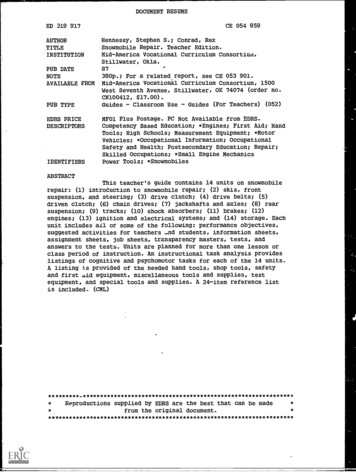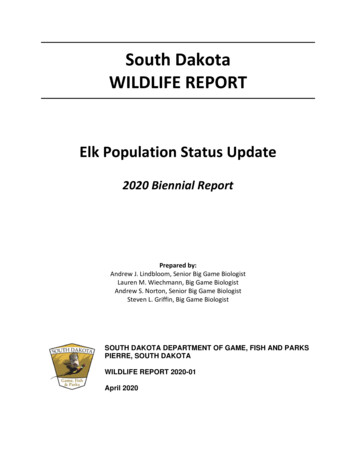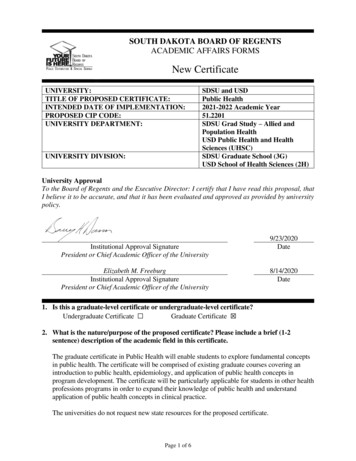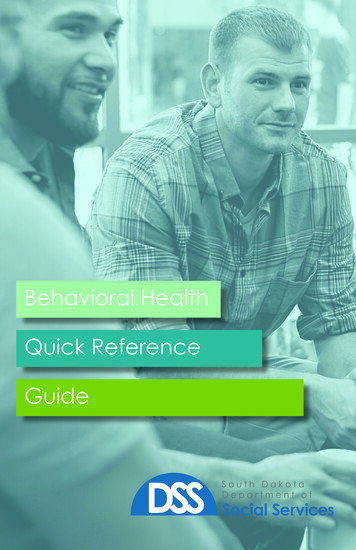
Transcription
Behavioral HealthQuick ReferenceGuideDSSSouth DakotaDepartment ofSocial Services
Table of ContentsUnderstanding Behavioral HealthAccess to Behavioral Health Providers and ServicesBehavioral Health Services and Eligibility CriteriaServices for Justice Involved IndividualsFunding for Behavioral Health ServicesSupporting Healthy RecoveryBehavioral Health Disorders FactsFrequently Asked QuestionsAdditional Resources137122527293236
Understanding Behavioral HealthWhat is behavioral health?Behavioral health is a key part of a person’s overall health. It isjust as important as physical health and includes one’s emotional,psychological and social well-being.Behavioral health conditions include mental health and substanceuse disorders. Mental Disorders are a disease (also called mental illness)causing mild to severe disturbances in thought and/orbehavior resulting in an inability to cope with life’s demandsand routines. Substance use disorder is a disease which occurs whenthe recurrent use of alcohol and/or drugs causes significantimpairments. Impairments may include health problems,disability and failure to meet major responsibilities at work,school or home. Co-occurring disorders are mental health conditionsin combination with any of the following: substance usedisorder, trauma issues, problematic gambling, medicalissues or developmental disabilities. Behavioral healthconditions are common. People of all ages, genders, racesand ethnicities have these conditions. They happen with or1without physical disabilities. If you notice a change in moodor behavior or alcohol or drug use is causing problems,consider a referral to a behavioral health care provider for anassessment just as one would seek guidance/assessmentfrom a doctor if experiencing a physical ailment. Help isavailable and recovery is possible.What is behavioral health care?Behavioral health care usually starts with screening and/orassessment and includes treatment, recovery services and support.Screenings can be quick questions. This brief process determinesthe likelihood that a person has a substance use disorder, mentalhealth or co-occurring disorder. The purpose of a screening is toestablish the need for a more detailed assessment, not to establishthe presence or specific type of disorder. A screening can detectdisorders early and treat them before conditions become worse.Assessments are conducted by a behavioral health provider togather information to establish the presence or absence of a mentalhealth or substance use disorder. A diagnosis can be made from anassessment, along with recommendations for treatment.Treatments are services like therapy or counseling, medicationmanagement and support services. Some treatments may includea residential or hospital stay. It is different for each person. Formany people, the best treatments are a combination of counseling,support services and medication, and most people are able to betreated on an outpaitient basis.Recovery/Peer Supports assist in managing behavioral healthconditions by providing social and emotional supports. Supportmay be from a behavioral health provider, support group, placeof worship or other community organizations. Family members,friends, caregivers and social networks may also be a part ofrecovery. Examples of recovery supports in South Dakota includeNational Alliance on Mental Illness (NAMI) and Face It Together.The process of recovery is different for each person.2
MH) provide mental health counseling including assessment,diagnosis and treatment of mental illness or mental andemotional disorders, individual, group and marriage andfamily counseling and psychotherapy; as well as providecrisis intervention.Access to Behavioral HealthProviders and ServicesBehavioral health providers are specially trained to work withpeople experiencing mental health and substance use disorders.They work in community mental health agencies, substance usedisorder treatment agencies, primary care clinics, hospitals, schoolbased counseling, college counseling centers and private practice.Types of Behavioral Health ProvidersThere are different types of behavioral health providers. In SouthDakota, there are several licensing boards that develop andestablish standards for professionalism and competence for theproviders they license or certify. Information about the licensingboards can be found atdss.sd.gov/licensingboards/ or doh.sd.gov/boards/.In South Dakota, examples of Behavioral Health providers include: Psychiatrists are medical doctors who diagnose mentalhealth and substance use disorders, prescribe and monitormedications and may provide counseling and therapy. Psychiatric or Advanced Practice Nurses/Certified NursePractitioners are nurses trained to perform advancedpractice registered nursing scopes including assessment,diagnosis and therapy for mental health and/or substanceuse disorders. They can also prescribe medication. Clinical Psychologists make diagnoses and providecounseling and therapy. Social Work Associate, Social Workers, Certified SocialWorkers and/or Certified Social Worker Private orIndependent Practice may complete assessments andmake diagnoses, provide treatment, including psychotherapyand counseling, and case management and other servicesto support recovery and health living. 3Counselors, Licensed Marriage and Family Therapist(LMFT), Licensed Professional Counselor (LPC) andLicensed Professional Counselors-Mental Health (LPC- Licensed or Certified Addiction Counselors andAddiction Counselor Trainees complete assessments,diagnose and provide treatment for substance use disorders.Additionally, behavioral health providers that have met professionallicensing in accordance with SDCL 27A-1-3 and ARSD Chapter67:62:14 may complete the Qualified Mental Health Professional(QMHP) training on commitment procedures for both childrenand adults. The QMHP training is needed for a behavioral healthprovider to complete an assessment or examination to be usedin an involuntary commitment proceeding. For more informationplease see: w do I find a behavioral health care provider?An important step to getting behavioral health care for yourclient is finding a provider. Community Mental Health Centers inSouth Dakota provide behavioral health services to adults andyouth including screening and assessments, case management,individual and group therapy and crisis intervention. Addictiontreatment agencies provide addiction treatment to adults andyouth including screenings and assessments, early interventions,detoxification, outpatient and inpatient treatment services.In addition, behavioral health providers who meet licensurerequirements may provide mental health and/or substance usedisorder treatment services in an independent or group pratice.To find a local provider, please call 1.855.878.6057 or visitdss.sd.gov/behavioralhealth/community/ or findtreatment.samhsa.gov/.How are behavioral health services accessed?1. Contact a local behavioral health provider to schedule anappointment.2. The behavioral health provider completes an assessment todetermine diagnosis and treatment needs.4
3. Based on the assessment, the behavioral health providerrecommends behavioral health treatment services.Substance Use Disorder AgenciesFor substance use disorders, addiction treatment agencies can beaccredited through the Division of Behavioral Health or operateunder the independent licensing authority. A list of accreditedaddiction treatment agencies can be found at: h Dakota Community Mental Health Centers CoverageAreaIn South Dakota, the Division of Behavioral Health (DBH) accredits11 community mental health centers and designates counties ofservice for each of the centers. These centers receive state andfederal funding to assist adults with serious mental illness andyouth with a serious emotional disturbance achieve their treatmentneeds in the community. A list of these agencies can also be foundat dss.sd.gov/behavioralhealth/agencycounty.aspx.CMHC Coverage Map56
Behavioral Health Servicesand Eligibility CriteriaMental Health Service DeliveryMany times, treatment provided on an outpatient basis is ableto meet the individual’s mental health needs. When the illnessbecomes more severe and impacts a person’s ability to functionindependently, the services available through South Dakota’sCommunity Mental Health Center (CMHC) system can addressthose needs. Through an assessment, an individual may beidentified as meeting criteria for Serious Mental Illness in adults, orSerious Emotional Disturbance in youth. Serious Mental Illness (SMI) is identified in adultswith diagnosed mental health disorders who are alsoexperiencing functional impairments which significantlyinterfere with daily living.Serious Emotional Disturbance (SED) is identified inyouth with diagnosed mental health disorders who are alsoexperiencing functional impairments which significantlyinterfere with functioning in the community, school andfamily, and need services in addition to mental healthservices.The following services are available to adults meetingeligibility criteria for SMI:Treated with psychotropic medication for at least one year Frequent crisis contact with a CMHC or behavioral healthprovider for more than six monthsAnd at least three of the following: Unemployed or limited job skills, poor work history Exhibits inappropriate social behavior resulting in concernby the community or requests for mental health or legalintervention Unable to obtain public services without assistance Requires public financial assistance for out-of-hospitalmaintenance or difficulty budgeting public financial assistanceor requires ongoing training in budgets skills or needs apayee Lacks social support systems in a natural environment orlives alone and is isolated Unable to perform basic daily living skills without assistanceIndividualized and Mobile Program of Assertive CommunityTreatment (IMPACT) provides medically necessary treatment,rehabilitative and support services for adults who require moreintensive services than can be provided through the CAREprogram. The IMPACT Team is a mobile group of mental healthprofessionals who merge clinical, medical, rehabilitation and staffexpertise within one service delivery team under the supervisionof a clinical supervisor.Comprehensive Assistance with Recovery andEmpowerment Services (CARE) includes outpatientcounseling, case management and psychiatric medicationmanagement for adults diagnosed with a serious mental illness.The individual, in order to meet IMPACT eligibility criteria,must meet the following: Medical necessity as determined by a clinical supervisor Meet the Serious Mental Illness CriteriaThe individual, in order to meet CARE eligibility criteria,must meet one of the following: Receive prior authorization by the Division of BehavioralHealth Voluntary consent from individual to receive IMPACT services No other appropriate community-based mental health serviceis available 7 Undergone psychiatric treatment more intensive thanoutpatient care more than onceSingle episode of psychiatric hospitalization with a majormental health diagnosis8
Is likely to need residential or institutional placement if moreintensive community-based services are not providedTransition Age Youth (TAY) is a residential living skills program inRapid City supporting young adults with serious mental illness asthey transition towards living independently.The following services are available to youth meeting eligibilitycriteria for SED:Child or Youth and Family Services (CYF Services) arespecialized outpatient services provided to youth including casemanagement, individual, group and/or family counseling. Familycounseling may include Functional Family Therapy, which is astrength based model for building skills to help improve familyrelationships, reduce behavioral issues and improve schoolperformance. A child or youth with a co-occurring disorder mayalso receive CYF services.Additional behavioral health services available to youth oryoung adults include:And at least four of the following: Has persistent or recurrent difficulty performing daily livingtasks except with significant support or assistance fromothers such as friends, family, relatives or community mentalhealth providers Has frequent psychiatric inpatient hospitalizations within thepast year Has constant or cyclical turmoil with family, social or legalsystems or inability to integrate successfully into thecommunity Is residing in an inpatient, jail, prison or residential facility andclinically assessed to be able to live in a more independentliving situation if intensive services are provided 9Has an imminent threat of losing housing or becominghomelessFirst Episode Psychosis (FEP) is a specialized programproviding early intervention services for youth and adults afteran initial diagnosis of psychosis. It is designed to support theindividual in meeting education, employment or other life goalsand reduce the challenges of living with a mental illness.If outpatient services are unable to meet the mental healthneeds of youth, the behavioral health provider can assess forhigher levels of care appropriate to meet the needs of the youthand coordinate referrals for residential placement if medicallynecessary.Psychiatric Residential Treatment Facility (PRTF) is a nonhospital facility that provides residential psychiatric services toyouth under the age of 21. Out-of-home residential psychiatrictreatment is provided to youth whose mental health needs areunable to be met effectively and safely in the community setting.Substance Abuse Service DeliverySubstance Use Disorder (SUD) is a disease which occurswhen the recurrent use of alcohol and/or drugs causes significant10
impairments. Impairments may include health problems, disabilityand failure to meet major responsibilities at work, school or home.Many times, outpatient treatment available through South Dakota’sSUD treatment providers is able to meet the individual’s needs.When the disease becomes more severe and causes significantimpairments, more intensive services including residential andinpatient treatment can address those needs.The following services are available to adults and youth:Early Intervention Services offer outpatient services toindividuals who may have substance use related problems buthave not been diagnosed with a substance use disorder. EarlyIntervention Services are available for both adults and youth.Outpatient Treatment Services provide treatment services in acommunity setting to individuals diagnosed with substance usedisorders. Outpatient Treatment Services are available for bothadults and youth.Day Treatment Services provide treatment services to adultsdiagnosed with substance use disorders in a structured, intensivetreatment program that may include a residential component.Low Intensity Residential Treatment Services providesresidential, peer-orientated treatment programs for adultsdiagnosed with substance use disorders whose living situation orrecovery environment is incompatible with recovery goals. Theprogram provides substance use disorder counseling with casemanagement services to prepare the client to live successfully inthe community.Services for JusticeInvolved IndividualsCriminal Justice Initiative (CJI) andJuvenile Justice Reinvestment Initiative (JJRI)What is the Criminal Justice Initiative?The Criminal Justice Initiative was established as part of the PublicSafety Improvement Act. The Department of Social Services(DSS) was tasked with establishing evidence based treatment andintervention programs for parolees and probationers. The targetoffender population includes offenders with Class 5 or 6 felonyoffenses identified with substance use disorders.What are the main objectives of the CJI?1. Improve public safety by investing in programs, practices andpolicies that have been proven to reduce recidivism 2. Hold offenders more accountable by strengthening communitysupervision. Inpatient Treatment Services provide residential treatmentwith medically monitored intensive treatment for individuals withsevere substance use disorders. Inpatient Treatment Servicesare available for both adults and youth.Detoxification Treatment Services are residential treatmentservices delivered by trained staff that provide 24-hoursupervision, observation and support for adults who areintoxicated or experiencing withdrawal symptoms.11Utilize research-based solutions that have been tested andproven in other states. The effective solutions focused onreserving prison space for violent and career criminals,slowing inmate population growth through recidivismreduction efforts and strengthening community supervision tothereby improve public safety.Strengthening supervision includes the following: utilizingearned discharge credits that encourage offenders to complywith supervision terms and allow the South Dakota UnifiedJudicial System (UJS) and the South Dakota Department ofCorrections (DOC) to focus their supervision resources onthose most at risk to reoffend, enhance and expand DUI andDrug Courts, and enhance probation and parole supervisionthrough evidence based practices (EBPs).3. Reduce corrections spending and focus prison space on violent,chronic and career criminals Reducing spending includes approaches such as the12
following: tiered controlled substance and burglarystatutes to differentiate among levels of criminal conduct,creation of more targeted punishments for Grand Theftand enhancement of available penalties for DUI offenders.Changes in these statutes increased penalties for the mostserious offenders.is common within at-risk populations. MRT addresses beliefs andmoral reasoning in a systematic, step-by-step group counselingtreatment approach. The program is designed to alter how clientsthink and make judgments about what is right and wrong. The MRTsystem approaches the problem of treating resistant populations asa problem of low levels of moral reasoning.The CJI reclassified drug possession and ingestion feloniesto Class 5 and 6 felonies with the presumption of probationsupervision. It also focused on evidence based programming(EBPs) and required the supervision of individuals on parole orprobation to employ EBPs and target the individual’s criminal riskand need factors with appropriate supervision and intervention.MRT seeks to move clients from hedonistic (pleasure vs. pain)reasoning levels to levels where concern for social rules and othersbecomes important. MRT research has shown that as clientscomplete steps, moral reasoning increases in both adult and youthoffenders.More information can be found at http://psia.sd.gov/.MRT systematically focuses on the following seven basic treatmentissues:CJI Evidence Based Programming (EBP)Two primary EBPs were selected based on their proveneffectiveness in addressing substance use disorder needs andcriminal thinking. Moral Reconation Therapy (MRT) was chosen toaddress criminal thinking and Cognitive Behavioral Interventions forSubstance Abuse (CBISA) was chosen to address substance usedisorder needs. Both programs are Cognitive Behavioral Treatment(CBT) models and both are delivered in a group setting. confrontation of beliefs, attitudes and behaviors assessment of current relationships reinforcement of positive behavior and habits positive identity formation enhancement of self-concept decrease in hedonism and development of frustrationtoleranceCBT programs encompass a therapeutic strategy designed tochange the cognitions that influence maladaptive behavior. CBTinterventions are also action-oriented. Participants engage in manyactivities, such as role-play, as part of the therapeutic process. CBTapproaches are focused on the present; therapeutic strategies areaimed at changing the current risk factors that impact a participant’sbehavior. Finally, there is a focus on learning with a CBT approach.Clients spend a significant amount of time in this group learning andpracticing new methods of handling risky situations. development of higher stages of moral reasoningMoral Reconation Therapy (MRT)MRT is a cognitive-behavioral program for criminal justiceoffenders. Developed in 1985 by Gregory Little, Ed.D., and KennethRobinson, Ed.D., MRT combines education, group and individualcounseling, and structured exercises designed to foster moraldevelopment in treatment-resistant clients. Poor moral reasoning13Cognitive Behavioral Interventions for Substance Abuse (CBISA) was developed by the University of Cincinnati CorrectionsInstitute and is designed for justice involved individuals that havea moderate to high need in the area of substance abuse. As thename of the curriculum suggests, this intervention relies on acognitive behavioral approach to teach participants strategies foravoiding substance abuse. The program places heavy emphasis onskill building activities to assist with cognitive, social, emotional andcoping skill development. The components of the curriculum includethe following:Module 1: Motivational EnhancementThe first module includes a series of sessions aimed to increasemotivation to engage in the intervention, including an explorationinto personal values, goals and resistance.14
Module 2: Cognitive RestructuringModule 2 focuses on cognitive restructuring. Just as the actionswe perform repeatedly become habits, the thoughts we repeatedlyhave also become habitual. The curriculum uses a behavior chainformat to emphasize the connection between thoughts, feelingsand actions to likely consequences. This teaches participants howtheir thinking led to feelings and then actions, ultimately resulting inassociated consequences.Module 3: Emotional RegulationOnce participants have identified situations that put them at riskto abuse substances and have begun to recognize the importantpart their thoughts play, the focus turns to feelings. Such feelingsfor participants include cravings and urges. This section uses abehavioral approach to understand, manage and control feelings.Module 4: Social SkillsIn Module 4, the curriculum uses a social learning model to trainsocial skills, including modeling, receiving feedback and practicing.Through behavioral rehearsal, participants receive training toincrease their pro-social interaction options.Module 5: Problem SolvingModule 5 progresses to the advanced skill of problem solving,which is critical for successfully navigating the world. Participantswill learn and practice the following eight steps to effective problemsolving: Stop to Think, Objectively Define the Problem, Identifya Goal, Brainstorm Possible Options, Choose the Best Option,Plan it Out, Take Action and Evaluate the Process. In this way, theproblem-solving process is directed by the individual participant andcan be applied to any type of problem the individual may face.Module 6: Relapse PreventionThe final series of sessions in Module 6 work on relapseprevention. Participants create an individualized plan based onrisky situations they identified in the beginning of the curriculum.The plan integrates the behavior chain format originally introducedin the cognitive restructuring module. Furthermore, coping options,lifestyle factors and support systems are included during theplanning activities.15After almost every session, homework is assigned so thatparticipants can practice generalizing the skill in their daily lives.The emphasis on homework greatly increases a participant’sability for longer-term change. Each participant is fully expected tocomplete the homework assignments during the intervention.With more than 25 group sessions, the curriculum covers keycomponents of the cognitive behavioral approach. By enhancingmotivation, recognizing risk, managing feelings, increasing prosocial behaviors and establishing a relapse prevention plan,the CBISA group curriculum provides individuals struggling withsubstance use disorders an opportunity to redesign their lives andfind freedom from substance abuse.16
CJI Referral Process Court Service Officers, Parole Agents, and ResourceCoordinators make referrals directly to the CJI ProviderAgency. Telehealth Based CJI ServicesCBISA and MRT are both offered to CJI clients statewide. Clientswho are unable to participate in on-site services can participatein CBISA and MRT services through the use of technology. Thisplatform alleviates many common barriers to clients attendingservices, including transportation, availability of services, child care,elder care, etc.CJI EligibilityCriteria for CBISA Referrals Target population is offenders with a Class 5 or 6 felony andclients that score medium to high on the alcohol/drug domainof the Level of Service Inventory-Revised (LSI-R) CBISA is a targeted intervention for justice involvedindividuals with a Substance Use Disorder (SUD)Criteria for MRT Referrals17 Target population is offenders with a Class 5 or 6 felony andclients that score medium to high on the overall LSI-R score MRT is a targeted intervention designed to address criminalthinking in justice involved individuals.The CJI Provider Agency contacts the client to schedulean assessment. The LSI-R is utilized as a starting pointto conduct the assessment. Upon completion of theassessment and determination the client is appropriate toreceive services in the community, a date to start services isscheduled.CJI ProvidersAs indicated in the referral process, the Division of BehavioralHealth (DBH) is not the provider of the CJI evidence basedprogramming. The DBH provides oversight of the CJI programsincluding the following: quality assurance reviews, priorauthorizations and programmatic support for both the provideragency and referral source. Community behavioral health providerswere selected in each circuit through a competitive bidding process.Each judicial circuit has at least one CBISA and one MRT provider.In addition, telehealth based services are provided statewide forboth CBISA and MRT.Juvenile Justice Reinvestment Initiative (JJRI)What is the Juvenile Justice Reinvestment Initiative?The Juvenile Justice Reinvestment Initiative (JJRI) was establishedas part of the Juvenile Justice Public Safety Improvement Act.DSS collaborated with the Department of Corrections (DOC) andthe Unified Judicial System (UJS) to identify, select and implementcommunity based treatment services for justice involved and at-riskyouth.What are the main objectives of the JJRI?1. Focus expensive residential placements on youth who are apublic safety risk2. Prevent deeper involvement in the juvenile justice system foryouth committing lower level offenses3. Improve outcomes by expanding access to evidence based18
community interventions4. Ensure the quality and sustainability of reformsDSS, DOC and UJS identified community based, evidence basedtreatment to be made available to juveniles with justice systeminvolvement based on the needs of the youth.DSS staff met regularly with UJS and DOC staff to determine thescreening tools, referral process and evidenced-based interventionsto be implemented. This group also met with stakeholders, suchas community agency directors, school district representatives,residential care representatives and county representatives, toensure feedback was obtained from all levels. At the conclusion oftheir research and collaboration, a consensus was reached thatFunctional Family Therapy (FFT) would be the initial intervention,with Moral Reconation Therapy (MRT) and AggressionReplacement Training (ART) to be added in 2017.More information can be found at http://jjri.sd.gov/.JJRI Evidence Based ProgrammingThe interventions selected were recommended by relevantstakeholders due to the wide range of needs represented byjustice involved youth. FFT addresses Substance Use Disorders,Internalizing Disorders* and Externalizing Disorders**; MRTaddresses crime and violence issues; and ART addresses angercontrol and Externalizing Disorders.*Internalizing Disorders consist of negativity that is focused inward.Youth experiencing internalizing behavior have difficulty coping withnegative and/or stressful situations. Examples include SeparationAnxiety Disorder, Generalized Anxiety and Obsessive CompulsiveDisorder.**Externalizing Disorders consist of problems regulating emotionsor self-control. Youth exhibiting externalizing behaviors directnegative and aggressive behavior outward. Examples includeAttention-Deficit Hyperactivity Disorder, Oppositional DefiantDisorder and Conduct Disorder.19Functional Family Therapy (FFT) is an intensive treatmentprogram targeting externalizing behaviors ranging from mild tosevere including substance use, family problems and acting outbehavior. FFT is based on the theory that families may developpatterns of relating that promote and maintain problem behaviors.Treatment involves changing the patterns of how family memberscommunicate, problem solve and get their needs met. In orderto accomplish this goal, the FFT therapist meets with the familyas often as necessary within the family’s home or location of thefamily’s choice. FFT is designed to be administered to the entirefamily unit, rather than an individual identified client. A familytypically participates in FFT for three to five months and theintervention is targeted for youth between the ages of 10 and 18.FFT is a clinical model that increases a family’s motivation tochange. There are five components of the family therapy:1. Engagement – Goal is to develop a positive perception ofthe therapist and program along with facilitating the family’swillingness to attend the first session.2. Motivation – Goal is to increase hope and motivation forchange, reduce negativity and blaming and address riskfactors associated with treatment drop-out.3. Relational Assessment – Goal is to identify relationalfunctions, and needs and hierarchy within the family.4. Behavior Change – Goal is to
young adults include: First Episode Psychosis (FEP) is a specialized program providing early intervention services for youth and adults after an initial diagnosis of psychosis. It is designed to support the individual in meeting education, employment or other life goals and reduce the cha

